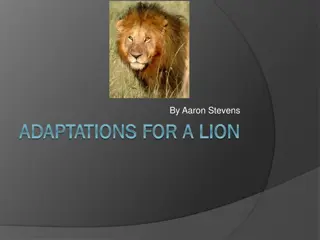Evolutionary Adaptations in Animals and Their Mouthparts
Environmental conditions have influenced the evolution of animals, leading to adaptations that allow them to survive and thrive. One crucial aspect is the relationship between animals, their environment, and food sources, shaping physical traits like mouthparts for efficient feeding. Explore how different animals' mouthparts are specialized for their specific diets, highlighting the intricate link between evolutionary processes and environmental factors.
Download Presentation

Please find below an Image/Link to download the presentation.
The content on the website is provided AS IS for your information and personal use only. It may not be sold, licensed, or shared on other websites without obtaining consent from the author. Download presentation by click this link. If you encounter any issues during the download, it is possible that the publisher has removed the file from their server.
E N D
Presentation Transcript
ANIMALS AND THE ENVIRONMENT Environmental conditions have shaped the evolution of every organism on the planet. From the structure of a maple tree's cells, to the camouflage of a praying mantis, to the wariness of a gazelle, countless physical and behavioral traits have grown out of the interaction between organisms and their environment. These traits, called adaptations, are the result of natural selection, and they give an organism the ability to survive and reproduce in a given set of conditions. Evolution - the process by which changes in plants and animals happen over time Adaptation - a change in a plant or animal that makes it better able to live in a particular place or situation Natural Selection - the process by which plants and animals that can adapt to changes in their environment are able to survive and reproduce while those that cannot adapt do not survive
FOOD AND THE ENVIRONMENT One component of the environment that has been particularly influential in the evolutionary process is food. Over millions of years, the amount and type of food available to a species has dramatically influenced both the manner in which individuals of that species find food and the physical traits that help them catch and eat their food most efficiently. As you view the following slides, consider the structure of the mouthparts and predict the type of food it is adapted to eat.























